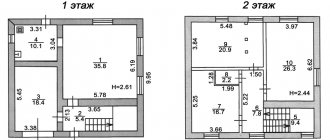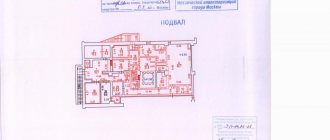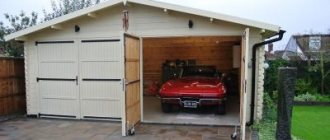What is a BTI plan? A BTI floor plan is a drawing of an apartment or non-residential premises, made according to the measurements of a technician from the Bureau of Technical Inventory. He notes the configuration of partitions, doors, windows, some dimensions, as well as the location of plumbing fixtures.
BTI plan - example
We will consider this definition in more detail in paragraph 1 of this article. In this article we will also look in detail at all the nuances relating to the floor plan and explication for an apartment or non-residential premises. We will give examples of these documents and answer the questions “How to get a BTI plan for an apartment or non-residential premises?” and “Where can I get a floor plan and BTI explication?”
Introductory word.
When a building is put into operation, it is necessary to carry out an inventory, that is, measurements. Several organizations have the right to carry them out, however, basically, this is done either by the Bureau of Technical Inventory or Rostekhinventarizatsiya. As a result of the measurements, an inventory plan-drawing of the premises is carried out. Thus, the size and area of the constructed property are legally fixed.
In other words, the BTI floor plan of an apartment or non-residential premises is a drawing of the premises, made according to the measurements of specialists from the Bureau of Technical Inventory. It is also often abbreviated as the “BTI plan”. In practice, a BTI plan is called any inventory plan, even if the measurements themselves were carried out by another organization, because the vast majority of objects were still inventoried by the BTI (Bureau of Technical Inventory). An explanation is always attached to the floor plan of an apartment or non-residential building.
Explication - what kind of document is this?
Explication is a list of all premises of an object indicating their areas. The purpose of the room is also indicated - main or auxiliary.
It should also be noted that the actual area of loggias in the explication is multiplied by a reduction factor of 0.5, and the area of balconies by 0.3.
Below we give an example of an explication.
Let us note that to legitimize the redevelopment of an apartment, a technical passport of the apartment is required, and not just a floor plan and explication, which are included in its composition. When agreeing on the redevelopment of non-residential premises, a BTI plan and explication along with an extract from the technical passport for the building and a certificate of the condition of the premises are sufficient.
Let's see what the BTI plan looks like.
What it contains
Click to enlarge the picture
This document contains:
- the exact address where the premises are located, cadastral number (you can read how to find out the cadastral number by address here);
- type of room, its functional purpose;
- date of last verification of the explication;
- data on the area of each individual room, as well as the total area of the room;
- purpose for examining the premises.
Please note: this document is drawn up after BTI employees have measured the object and entered the readings into the original version.
When compiling an explication, they use the regulatory document GOST 21.501-93 SPDS Rules for the implementation of documentation of architectural and structural solutions.
2.1. BTI floor plan.
The vast majority of residential and non-residential buildings were inventoried by the BTI (Bureau of Technical Organization), so their documents were most widely used. We only note that on such plans only the main dimensions of the premises are indicated, and not all. Otherwise, bringing all the dimensions of the room into the drawing would make it unreadable. In the archive, in the file of the object, a plan of the premises should be stored with all the dimensions that were measured upon entering the object.
2.1.1. Floor plan and explication of the apartment from the BTI.
This document is made in A4 format and represents the layout of the apartment with the main dimensions and room numbers. At the entrance to the apartment its number is placed. Also, the sheet must be stamped with the stamp of the BTI department that issued the document. The date when the last measurement of the premises was carried out, as well as the date of issue of the document itself, must be indicated. The explanation provides the purpose of each room and its area.
If, at the time the surveyor arrives at the apartment, an unapproved redevelopment has been carried out in it, then he will mark the changes made on the drawing with red lines:
An appropriate mark is also placed on the sheet about the refurbishment of the premises carried out without permission. In the Moscow region, deviations are not highlighted with red lines, but are only marked.
2.1.2. BTI plan for non-residential premises.
This document is drawn up in a similar way to what we described in the previous paragraph. If the documentation is drawn up for the entire non-residential building, then it will consist of several drawings for each floor with a separate explication of the premises. If the room is large, then the drawings can be drawn up even on A0 sheets.
Commentary on the video: Now you don’t need to fill out an application: just tell the operator who accepts documents at the MFC or TBTI whether you need a technician to take measurements or not. From the summer of 2017 to the present (2021), a BTI plan can be ordered without a technician taking measurements only if the last such measurements were carried out no more than 5 years ago. In this case, you can request an archival copy of the BTI plan and an explication. You can do this online here. You must register, select “Submit an application online” and fill out all the data in the same way as the application. Also, through the BTI website, you can order a BTI plan in electronic form, current at the time of the last examination, without explication and stamps.
List of useful documents
| No. | Links | Description |
| 1 | Sample technical passport | |
| 2 | Sample USRN extract | |
| 3 | Sample technical plan | |
| 4 | Sample defect sheet | |
| 5 | Sample Floor Plan | |
| 6 | Application for cadastral registration | |
| 7 | Instructions for the applicant when submitting documents to the MFC | |
| 8 | Sample explication (statement) of premises |
2.2. Inventory plan from Rostekhinventarizatsiya.
Despite the fact that this organization has existed for quite a long time, developers began to contact it more or less regularly only in the 2000s. In general, Rostekhinventarizatsiya (abbreviated as Rostec) is famous for being less conservatist than BTI: it is easier to understand various borderline situations, and it is also much easier to correct errors made during measurements.
It should be noted that the Housing Inspectorate has stopped accepting technical passports, inventory plans and explications from Rostekhinventarizatsiya unless they have inventoried the entire house. Only documents from the BTI are accepted.
2.2.1. Floor plan of the apartment from Rostec.
Externally, this document is drawn up almost the same as in the BTI. The plan must be stamped with the organization's seal and the date of issue of the document must be indicated. In case of illegal redevelopment, a mark indicating its presence is also made.
2.2.2. Floor plan of a building from Rostec (non-residential premises).
Documents for non-residential premises are prepared in a similar way. Outwardly, it is even very difficult to distinguish them from documents executed by the BTI - only by the executor’s mark in the stamp.
Where can I get the BTI plan and explication?
In general, you can order a BTI plan and explication directly at any branch of the Bureau of Technical Inventory or MFC, providing a passport and a document certifying ownership of the object (certificate of ownership or an extract from the Unified State Register). If you do not provide them, then the BTI itself will order data from the Unified State Register, but this will take time. You can also order the BTI plan and explication in electronic form through your personal account on the website mos.ru.
Now let's look at this issue in more detail. Not all houses were inventoried by the BTI. To order BTI, you first need to find out which organization carried out the measurements of your building. This is where you need to order documents. If your apartment or non-residential premises is located in a residential building that was built a long time ago (before 2000), then the measurements were carried out by the BTI. If an apartment or non-residential premises is located in a building of a later year of construction, then measurements could be carried out both in Rostekhinventarizatsiya and in BTI. Although, most often, developers still turned to BTI. If your entire building is non-residential, any year of construction, then measurements could be carried out by either of these two organizations (but in BTI much more often).
In any case, you can always call BTI or Rostec directly (we will provide contact details below) and find out which of them has inventoried your property. If your property is located in a new building, then it is easiest to take inventory plans from the developer or management company, since they have recently commissioned this property, which, as we have already said, must be inventoried upon commissioning. Also, in some new buildings that were put into operation quite recently, inventory was ordered from individual cadastral engineers. They do not have the right to issue a technical passport for the apartment. In this case, it is necessary to carry out an initial inventory in the BTI based on the architectural and construction plan from the developer. We wrote more about this in the article about coordinating redevelopment in a new building.
Where is it used and why is a premises list needed?
In cadastral registration, the premises register is not used; all data from such a register is presented as a technical plan. If you need to obtain an explication of the premises based on the results of a technical inventory that took place before 2013, then you can request it from the archive or inventory file of the BTI. These bodies were engaged in technical reporting and inventory of the housing stock before the cadastral registration system was introduced. The validity period of the explication will correspond to the validity period of the technical passport.
3.1. Where can I get the explication and floor plan of the apartment?
Thus, you need to apply for documents to the organization that carried out the initial measurement of the building.
3.1.1. Where can I get a floor plan and BTI explication for an apartment?
If the building in which the apartment is located was measured by the BTI after construction, then the plans can be ordered either directly from the BTI department or from the MFC (Multifunctional Center). All of them operate on an extraterritorial principle, that is, you can order documents at a branch in any district. However, it is best to order a BTI plan directly from the BTI department. This way it will take the least amount of time to make. The documents are still sent there if you ordered a floor plan and an explication of the premises at any branch of the MFC, and the transfer takes additional time. The addresses of the divisions of the Bureau of Technical Inventory, telephone numbers and their operating hours can be found at this link.
3.1.2. Where can I order a floor plan of an apartment and an explication if the measurements were carried out by Rostec?
In this case, you cannot order documents through the MFC. Moreover, if you unknowingly ordered a BTI floor plan from the MFC, and the initial measurement of the building was carried out by Rostekhinventarizatsiya, then the submitted application will be returned back, and you will simply waste time. In this case, you must contact directly the one window of the Rostekhinventarizatsiya office, which is located at the address: Moscow, Gusyatnikov lane, building 11. Office phone number.
When is it carried out and who compiles it?
At the stage of inventorying the premises and drawing up a plan, explication is also carried out. It looks like a regular table, which indicates the number of floors in the building, its area, ceiling height, and purpose. The more parameters specified, the better. According to many experts, everything that does not fit into ordinary regulatory documents can be entered here, since the explanation sheet (EL) does not have a clear structure and restrictions on the number of parameters.
Together with the floor plan, this document simplifies the task of the appraiser and speeds up the procedure for selling and purchasing premises.
Without EL, it is impossible to put the premises into operation in some regions of the Russian Federation due to inconsistencies in the legislative framework and due to regional characteristics.
The purpose of the premises is not specified in every document, and there are cases when the standard package does not contain information at all: what the building is used for and where it was previously used.
An important role is played by the fact that apartment and multi-storey buildings are required to be registered with the cadastral register, because in this case it is also necessary to carry out an explication of all premises.
An explanation is also needed when applying for a mortgage from a bank. Issued to the apartment owner after the inventory procedure.
How to order an apartment plan from BTI or Rostekhinventarizatsiya?
So, we have identified the organization from which it is necessary to order the floor plan and explication, and we also found out the address of the office to which the documents must be submitted. Now let’s take a closer look at the documents that need to be provided in order to make a BTI plan, as well as the nuances associated with them.
To order a floor plan and explication of apartment premises, both the BTI and Rostec must submit the following documents:
- Identity document - passport;
- Certificate of state registration of rights or an extract from the Unified State Register of Real Estate (or other title document). If the owner is registered in this apartment, then there is no need to provide ownership documents. If there is no certificate of ownership, then the BTI will themselves order an extract from the Unified State Register of Real Estate upon an interdepartmental request, but this will take additional time;
The apartment owner or an authorized representative must submit the documents. In the second case, he must have a properly executed notarized power of attorney. If the apartment is owned by several owners, then an application from only one of them is sufficient.
Now let's talk about one very important aspect. A floor plan for an apartment can be issued either with access to the site and new dimensions of the room, or simply as a copy of the old plan stored in the archive (database). You yourself tell the BTI employee who accepts the documents to simply make you a copy of the plan or carry out repeated measurements of the apartment. As we have already said, if there is any redevelopment in the apartment relative to the plan that is in the archives of the BTI or Rostec, the specialist will draw it on the floor plan in red lines and put a stamp on the illegal redevelopment. Thus, you yourself will “light up” your redevelopment, which is absolutely better not to do. Often, the owners themselves do not know that the layout of their apartment was once changed, say, by the previous owner. Therefore, you should always order a floor plan and an explication of the apartment without having specialists take measurements. They will be given to you based on the data that is in the archive. After receiving them, you will be able to independently check the compliance of this plan with the actual layout of the apartment. It only makes sense to call a specialist to measure an apartment when you have agreed on the redevelopment and received the appropriate permission to do so. But we will talk about making changes to the BTI plan later.
When submitting such an application, no one will come to the apartment. You will be given a floor plan for the apartment with the layout that is stored in the BTI archive.
Unfortunately, it should be noted that since the summer of 2017, BTI has still been conducting inventory (measurements) of the facility with a technician visiting it, if the last measurements were made more than 5 years ago. In this case, to avoid going to the site, order an archival extract of the BTI plan and explications through the BTI website, and also order on the BTI website, the link to which we have already given above, an electronic BTI plan of your apartment, current at the time of the last inspection for 250 rubles . True, they provide it without esplication and the necessary stamps.
How to get a BTI plan for an apartment?
After the necessary documents have been submitted to the BTI department, they will issue the corresponding extract:
It is necessary to check the correctness of the address of the object and the list of requested documents. The extract indicates the date the documents were ready, as well as the date the specialist went to the site, if he was ordered. The corresponding statements are issued both at the Multifunctional Centers and at the Rostekhinventarizatsiya office, if you submitted documents from them. Along with the statement, you will receive an invoice for the services provided, which can be paid there through the terminal. Documents are put into operation only after presentation of the corresponding check or receipt for payment made.
Receipt of the floor plan and explication of BTI or Rostec occurs in the same place where you submitted the documents on any day following the date of readiness of the documents indicated in the extract.
How to order a floor plan and explication for a non-residential premises?
These documents should also be ordered from the organization that carried out the initial inventory of the building (see paragraph 3 of the article). In this case, if the owner of the premises is a legal entity, the following documents are submitted:
- Passport;
- Certificate of state registration of the right or lease agreement (or other title document depending on the type of ownership of the object);
- Power of attorney for the person submitting the documents, executed on the organization’s letterhead with its seal;
- Letter of guarantee;
The letter of guarantee is filled out on the organization's letterhead with the date and reference number. Certified by the seal of the organization, the signature of an authorized person and the signature of an accountant. The letter of guarantee specifies which documents need to be produced, the number of copies, the address of the facility, the bank details of the company, and also provides obligations to pay for the services provided. If the documents are submitted by the tenant, the letter of guarantee must be certified by the seal of the owner organization.
Just like for apartments, the floor plan and explication of non-residential premises can be ordered with or without calling a measurer to the site. In the first case, the floor plan is obtained from archival information, in the second, based on the results of field measurements at the site. Just like for apartments, we recommend ordering documents for non-residential premises without calling a measurer. If during the measurement process deviations from the layout of the premises, which are presented in the BTI or Rostec archives, are revealed, the specialist will draw them on the plan with red lines and add a note indicating the presence of an uncoordinated redevelopment:
BTI floor plan for non-residential premises in red lines.
Thus, you yourself will “disclose” your illegal redevelopment in official documents. It will be impossible to remove red lines without obtaining appropriate approval. If the non-residential premises are located in a residential building, then you will have to apply for approval to the Housing Inspectorate, which will automatically issue a fine for the presence of red lines. Now for legal entities, according to paragraph 7.21 of the Code of Administrative Offenses of the Russian Federation, the fine is already 40-50,000 rubles.
The request to complete the floor plan with a specialist visiting the site for measurements is indicated in the letter of guarantee. If it says nothing about examining the premises, then the preparation of documents implies the issuance of information about the layout without taking measurements. Below we provide examples of such letters of guarantee.
An example of a letter of guarantee to TBTI without calling a measurer.
An example of a letter of guarantee to TBTI calling a specialist for measurements.
If the owner of a non-residential premises is an individual, then to order a BTI plan he will need exactly the same documents as for apartments (see paragraph 3 of this article).
After placing an order, the person accepting the documents will issue an invoice, which is paid directly from the bank account of the legal entity ordering the documents. Work on preparing the plan begins only after receipt of payment from the current account. In the case of an individual, the bill can be paid at the terminal.
Sample statement for 2020
You may be interested in the problem of what a defective statement document should look like. If we turn to the legislation, we cannot find mandatory requirements for how a defective statement should be drawn up. However, it is possible to generate a standard sample statement taking into account the requirements that apply to similar documents. In general, the statement should contain the following information:
- There must be the name of the form and its details, such as number and date;
- Details of the entity that will draw up the statement, it can be an enterprise or an individual;
- What the upcoming work contains, the specific object of their implementation;
- The amount of work to be performed must be in units of measurement;
- Signatures of the persons who conducted the survey and compiled a list of work to eliminate deficiencies.
For any work that is indicated in the defective statement, it will be necessary to prove the expenses incurred; the results of mutual settlements between the customer and the contractor will depend on the accuracy of the description of the defects and the planned work to eliminate them.
If we talk about practice, then the defective list may have been compiled using many types of technical documentation for the buildings or premises located in it. To do this, it is possible to use a technical passport and floor plan, technical plan and operational documentation.
If you need a standard sample statement, you can find it on our website. We strongly advise you not to undertake the preparation of the statement yourself; it is best to entrust this to our professionals.
Validity period of the explication and floor plan.
Floor plans and explications of the BTI and Rostekhinventarization do not have an assigned validity period.
However, the validity period of the BTI plan (newness of the document) can be assigned by the organization to which it will be provided. In other words, such an organization may require that the BTI plan be issued no more than six months or a year ago from the date of its provision. For example, most housing inspectors stopped accepting documents with a site inspection more than 5 years ago.
How much does an explication and floor plan cost?
The cost of documents varies greatly depending on the type of object and the organization in which they are performed. We also note that prices may vary significantly in each specific city. The data below is relevant only for Moscow. For the Moscow region, prices are slightly different.
8.1. The cost of the floor plan and explication of the apartment.
So, how much does a BTI plan cost for an apartment? In BTI, the price of producing a plan directly depends on the area of the object, as well as on whether a specialist will visit the object to take measurements. Details about the cost of the BTI plan can be found here.
Prices for preparing a floor plan in Rostekhinventarizatsiya are approximately twice the prices in BTI and are also calculated by area.
Explication of the apartment is
The explication of the apartment is a table with a description and area of all the premises included in its composition. This document contains information:
- about the individual characteristics of each apartment room (height, width, area);
- about the total area of the entire facility;
- about the presence of a change in the address of the object, indicating the current and previous addresses;
- about the absence of encumbrances (their presence).
The explication must be included in the technical and cadastral passports of real estate objects. However, it can be ordered and received in the form of a separate document.
Sample description of the area of an apartment:
| Litera, floor | Room number according to the building plan | Purpose of parts of premises | Total area of the room | Including area | Height of rooms according to internal measurements | Unauthorized converted area | Note | ||
| from her | Loggia. balconies, terraces, verandas | ||||||||
| residential | utility room | ||||||||
| 1 | 2 | 3 | 4 | 5 | 6 | 7 | 8 | 9 | 10 |
| A | 1 | Living room | 20,0 | 20,0 | 3,20 | ||||
| 7 | 2 | Kitchen | 9,8 | 9,8 | |||||
| 3 | Bathroom | 6,0 | 6,0 | ||||||
| 4 | Corridor | 13,1 | 13,1 | ||||||
| Total per sq. 73 | 48,9 | 20,0 | 28,9 | ||||||
Time frame for preparing the floor plan and explication.
Officially, the floor plan and explanation for the apartment must be prepared by the Bureau of Technical Inventory within 10 days, regardless of whether the technician is planned to enter the site or not. In practice, the plan and explication in the BTI without going to the site are prepared in 5 - 10 working days, with access - in 10-15. These deadlines are relevant if documents were submitted directly to the BTI department, and not to the MFC.
The time frame for producing a floor plan and explication for an apartment in Rostekhinventarizatsiya is approximately the same.
The time it takes to prepare a floor plan for a non-residential premises greatly depends on its area and is calculated individually each time. On average, its preparation takes about three weeks.
Defective premises list
The technical documentation for the premises includes a defective statement, these papers:
- They are not considered official, they are not included in the application of the technical passport or plan;
- They are considered an act that is drawn up after a visual inspection of the premises and identification of defects, any shortcomings or damage to walls, windows, doors, floors and equipment, as well as other parts;
- This document is made in order to carry out major or current repairs of structures, floors, windows, doors and other parts.
The defective statement can be considered the basis for preparing estimates for future repairs in a given premises, as well as a means of justifying the costs incurred. In the statement you can see elements of the floor, walls, windows, doors and so on, they must be replaced or restored. The defective list is used only when carrying out current or partial overhaul; it cannot replace design documentation during the construction or reconstruction of objects. Even if you contact government services or the MFC, then there | such a document will not be made.
Decoding BTI.
Despite the fact that the floor plan is an architectural and construction drawing, the designations on the BTI floor plan of certain elements are very different from those approved by construction GOSTs. Apparently, this happened historically. Below in the figure we show the symbols of the main elements on the BTI plans.
Symbols on the BTI floor plan.
It should be noted that furniture is not indicated in any way on the BTI plans. Only built-in wardrobes whose walls are made in the form of partitions (but not furniture cabinets) can be marked. Plumbing fixtures on the plans include a shower, sink, toilet, bidet, hygienic shower, bathtub and stove. At the same time, all other appliances are not marked on the BTI plans: radiators, risers, heated towel rails, ovens, washing machines and dishwashers, refrigerators, air conditioners, etc. The material and floor covering are not specified.
It is impossible to determine the purpose of the walls, that is, whether they are load-bearing or not, using the BTI. In most cases, load-bearing walls are drawn thicker, but not always. A load-bearing wall can be drawn thin, and, conversely, a non-load-bearing wall can be drawn thick. According to BTI plans, only an experienced specialist who has seen thousands of such plans and apartments can determine load-bearing walls, and even then not always.
On the BTI plans, only the main dimensions are indicated, without filling the drawing with them. At the same time, the BTI archive must contain a plan of the measured apartment and premises indicating all dimensions. True, not all objects, especially old ones, have such plans in the archive.
Making changes to the BTI plan.
If you plan to carry out work in your apartment or non-residential premises to change their layout relative to the one indicated on the floor plan (or they have already been carried out), then these changes must be made to the inventory plans only after receiving the appropriate approval from the authorized body. Without this approval, as we have already said, changes in the layout will be indicated on the plan with red lines, and will also make an inscription in the plan about the presence of an unauthorized redevelopment. In the Moscow region, they are limited to only the inscription, and changes are drawn in black. We discussed in detail the procedure for obtaining such approval in a separate article.
Also, quite often, BTI specialists, when measuring and executing a floor plan, make mistakes in the drawings and draw something incorrectly. Unfortunately, it can be difficult to prove something to the BTI, especially if the apartment has been renovated (they will always say that there is no mistake in the plan, but you changed it during the renovation). However, in some cases it is possible to correct the error.
To do this, a statement is written to the BTI department of your district addressed to the head with a description of the mistake made and the problem, to which is attached the maximum amount of evidence. For example, BTI technicians often confuse the location of the window and door when entering the balcony (switching their places). In this case, you can take photographs of the facade of the building or window and door openings in the same apartments on other floors, which will show the correct location of the window and door. After all, if the window and door are located like this in almost all apartments along the riser, then the house was originally built this way. The BTI will look at these photographs, the location of the window and door in the plans of similar apartments on other floors and correct the error.








